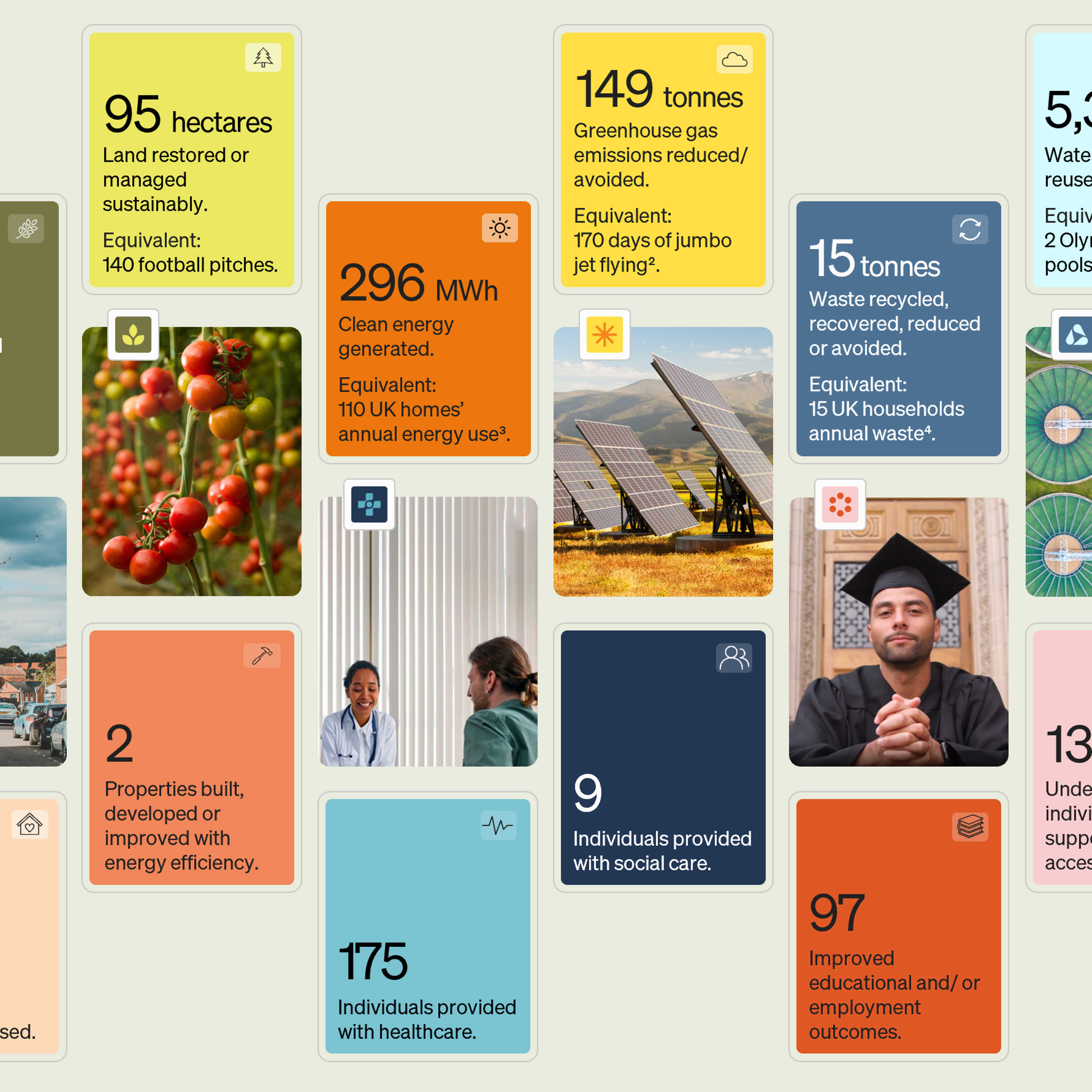Balancing impact and returns in a changing market: Snowball’s evolving approach to private credit

Surabhi Narendranath
Thu 31 July 2025

At Snowball, our goal is to unlock high-impact private market opportunities for investors, without compromising financial returns.
We target a 7% return net of fees over the long term and strong, measurable impact through a balanced, diversified portfolio. Over the past 8 years, we’ve learned that achieving this balance is often more difficult than investing to maximise a single goal - either financial returns or impact. It’s a constant learning process. But for us, achieving both goals in tandem is essential to attract capital at scale into solutions that meaningfully address critical global challenges.
Only ~1% of global assets are managed with impact in mind (using the GIIN classification and market sizing). That means 99% are still invested without regard to people or planet.
We want to change that.
But our role goes beyond identifying compelling investment opportunities across major asset classes and six broad themes*. We also continuously evolve our portfolio construction to navigate market shifts and optimise both financial and impact risk-adjusted returns. In this blog, we bring this to life by tracing our journey in one asset class - private credit - over the past two years.
The mother of all interest rate shocks
When Snowball launched, the impact investment space was still emerging. In our early years, we allocated significantly to investments in UK-based charities and social enterprises including through charity bonds (bonds issued by charities providing housing, specialist support and community programs and regional community-owned renewable energy projects). These investments were both impactful and catalytic in growing the then-nascent retail charity bond market. However, when interest rates surged by 500 basis points in 2022–2023, we faced hard questions such as:
Were we being adequately compensated for risk?
Could charities refinance at the new higher level of interest rates?
Was our capital still playing a catalytic role?
The answer, increasingly, was no. So, in 2023, we paused new investments in this space and reduced exposure, freeing capital for more compelling opportunities in impact private credit.
A growing, maturing private credit market
Private credit has boomed since the Global Financial Crisis - 10x growth since 2009 to $2T by end-2023 - driven by a pullback in traditional bank lending to SMEs. Within impact investing, it’s also expanding rapidly:
+184% growth in private debt impact funds over the past decade
423 funds active
€66B raised since 2015 (Phenix Capital)**
As markets adjusted to higher rates, we saw more funds offering:
High single-digit returns backed by contractual cash flows
Strong impact additionality
Still, caution is warranted. With no major recession during this private credit boom, we won’t fully see underwriting flaws until the next downturn. That’s why we prioritise fund manager expertise in underwriting, designing structural protections and risk management. In impact private credit, it also means understanding how to preserve impact in distress or restructuring scenarios.
Strategic asset allocation in action
In today’s uncertain macro environment, private credit stands out for its defensive characteristics - especially relative to more volatile public equities.
Using the flexibility within our Strategic Asset Allocation (which prescribes ranges for the size of our allocation in each asset class), we decided to:
Overweight private credit
Underweight public equities
We looked for evergreen impact private credit funds to manage our liquidity needs, with features such as:
Monthly/quarterly subscription and redemption windows
Underlying portfolios of short-maturity loans with recurring cash flows (cash coupons, principal amortization)
Faster capital deployment (minimizing the “J-curve” effect)***
Our 2024 private credit commitments – focus on developed markets
Community Investment Management - US
What it is
An evergreen strategy providing debt funding and strategic support to fintechs that improve financial inclusion for underserved small businesses and low-income households in the US.
Financial highlights:
Predominantly floating rate exposure aims to mitigate interest rate risk.
10-year track record, low historic volatility and low correlation with public markets.
Asset-backed lending (instead of direct lending to fintechs).
Data-driven underwriting and risk management underpinned by visibility over millions of underlying loan transactions originated by the fintechs.
Expertise in designing and negotiating structural protections and credit enhancements.
Impact highlights:
Fintechs use digital transaction data to lend to small businesses considered too risky by banks (for example, because they are young businesses, haven’t taken on a loan before, or do not have traditional hard assets to offer as security).
Strategy seeks to achieve 2–3x more lending to women-, minority-, and veteran-owned small businesses vs banks.
Small businesses gain access to a range of financial services including working capital loans, invoice factoring, charge cards, payment services, savings accounts and digital tools to help with cashflow forecasting and expense management. This enables them to grow and create opportunities for employment and wealth creation within their communities.
Key impact risk is irresponsible lending practices causing over indebtedness amongst vulnerable borrowers. What gave us comfort is CIM’s long history of public advocacy in the US for more responsible lending practices, including co-authoring the “Small Business Borrowers’ Bill of Rights”.****
Pre-investment, CIM looks for alignment with global standards for client protection. Post-investment, it looks for evidence of borrower savings vs high-cost alternatives like payday loans, credit score improvements and customers graduating to better products over time.
Three Hills Impact Fund - Europe
What it is
An experienced manager’s first dedicated impact fund, building on a 10+ year track record of providing flexible, non-dilutive growth capital alongside strategic value-creation support to mid-sized European businesses. Helps businesses execute their next phase of growth, such as launching new products, mergers & acquisitions, or expanding into new geographies.
Financial highlights:
Double-digit historic returns.
Hybrid approach: fixed-income-like instruments with contractual returns + minority equity stakes.
Focus on companies with conservative capital structures such as limited prior debt and large equity cushions.
Downside protection: through covenants, controls, board seats, information rights.
Impact highlights:
Although this is the first standalone impact fund, c.50% of capital invested over previous decade has been in impactful businesses across a range of sectors: circular economy, renewables, EV charging, healthcare, education, social care, recycling, waste management.
Impact is integrated throughout the investment process. For example, Three Hills holds impact workshops with pipeline investee companies early in the process – to explain why improved impact management and reporting can drive value creation and ensure alignment with company management on impact strategy and goals. Three Hills also considers impact on exit, by seeking responsible buyers for the business, and encouraging companies to certify their sustainability credentials, for example, through B-Corp assessment.
Independent review and validation of impact metrics and targets by Tiresia (European academic institution research partner).
First investment: leading provider of agrifood B2B technology solutions for the specialty crops segment in Spain and Latin America, which aims to enhance efficiency in the Agri value chain by reducing food waste; water, energy and fertilizer consumption; and CO₂ emissions.
What’s next
In the second half of 2025, our focus will shift to emerging markets private credit - a space where we see growing opportunity. We’ll share more later this year.
We hope this blog offered a window into how we adapt to external shocks while staying true to our mission: balancing impact and financial performance for long-term, systemic change.
We’d love to hear from you.
Questions? Thoughts? Feedback?
Please contact us at hello@snowball.com.
References.
*Snowball targets three Social Impact themes (Homes and Communities, Equity and Inclusion, Health and Wellbeing) and three Environmental Impact themes (Resource Efficiency, Regenerative Ecosystems and Energy Transition).
**Phenix Capital, Phenix Capital: Private impact debt funds raised €66bn since 2015 | Impact Investor
***The “J-curve” effect is seen in some private market investments when capital is drawn down and deployed over a period of multiple years but fees are charged on the entire amount committed, resulting in lower (and often sharply negative) net-of-fee returns in the initial years, but stronger net-of-fee returns in the later years when the fees are spread over a larger base of capital invested and the underlying investments mature and increase in value (the year-by-year returns profile resembles a slanting letter “J” or the shape of a hockey stick).
****Small Business Borrowers' Bill of Rights | RBLC
Disclosures.
The information in this blog post is for informational purposes only and is not an offer to sell or the solicitation of any offer to buy securities. Any such offer will be made only through respective offering materials, which will be available only to Qualified Purchasers. The statements in this blog post are qualified in their entirety by the disclosures in the offering materials.
References made to endorsements by any third-party provider to invest with Community Investment Management("CIM") are not indicative of future performance and do not imply any guaranteed level of service, skill or training. Investors should not rely on endorsements for any purpose and should conduct their own review prior to investing. This endorsement was given by a current investor. Snowball Impact Investments is not a “promoter” but is otherwise considered a third-party provider who is Not Compensated by CIM.


